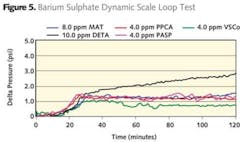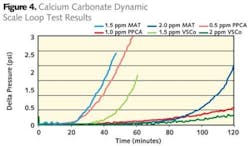Field Comparison of an Ultrasonic Microbial Control Program With a Conventional Bromine Microbial Control Program
By Donald W. Weakley
Keeping cooling water free from microbial contamination is a goal most every facility manager wishes to achieve. While oxidizing biocides are effective, many in the industry would like to reduce or replace chemical treatment with more environmentally responsible technologies. As a result, some industry suppliers have been instrumental in developing non-chemical treatment approaches that have proven to be effective in commercial applications.
As an example, Ashland Inc. developed its Sonoxide™ ultrasonic water treatment system, which can reduce biofilm formation and improve microbiological control. A recent study compared the performance of Ashland's system and that achieved with a conventional bromine microbial control program.
Fig. 1. Diagram of the compressor system used in the validation study indicating the location of the novel ultrasonic equipment.
The ultrasonic treatment technology used in this comparative study operates with a unique mode of action to control microbiological growth in circulating cooling water systems. The use and operating principles are covered by several international patents for cooling water treatment applications for numerous industries.
This patented technology works by passing water through an ultrasonic chamber, where bacterial cells are exposed to a combination of low-power, high frequency ultrasound and micro-bubble aeration. The emitters inside the chamber are in direct contact with the fluid being processed. When exposed to the ultrasonic frequency, some bacteria cells die and some become impaired enough that over time, overall bacteria levels are reduced and the biofilm is eliminated from the cooling water system.
Selecting the proper size equipment is a critical factor to ensure optimal results. The system size is based on water quality, e.g., chemical oxygen demand (COD) and total suspended solids (TSS), and system dynamics, including volume, effluent water loss rates, and average retention time. It is also vital to align the system hydraulics within a volume reprocessing specification range that also balances a specified stress recovery time for bacteria.
The stress recovery time is the period required to repopulate after the bacteria have been traumatized by the ultrasonic frequency. Chamber size can vary and can contain from six to 48 ultrasonic emitters each. If the system volume and hydraulic dynamics dictate larger processing flow requirements, multiple units can be deployed in a parallel configuration.
Comparative Study
The purpose of this study was to compare the efficacy of ultrasonic microbiological control technology with that of conventional oxidizing biocides in a circulating cooling water system. To maintain proper control of the test, only stabilized bromine would be used as the control to test against the ultrasonic equipment.
Testing protocol was established with sample collection, laboratory tests, monitoring and data logging identified. Fouling and corrosion data as well as water quality data were monitored and recorded using an OnGuard™ portable field monitoring analyzer, which is a side-stream monitor built in accordance with National Association of Corrosion Engineers (NACE) standards and recommended practices for online monitoring of cooling waters.
A medium-sized manufacturing facility that makes fluorescent lighting tubes in the U.S. Midwest was selected for the study. This facility has three cooling water systems. Each system is different and has different heat loads and circulation rates, and the water in each system cools vastly different equipment. The system selected for this study was an air compressor cooling system. The cooling tower operates between 3.5 and 4.5 cycles of concentration. Tower makeup water quality is shown in Table 1, and Figure 1 is an overview of the compressor system.
The data for this study was collected over a 12-week period. The study was divided into two six-week parts: the first part studied the existing stabilized bromine program, and the second part studied replacing the bromine program with the ultrasonic program. Data collection and testing procedures were held constant throughout the testing period.
For the duration of the study, all non-oxidizing biocides were removed from the system to ensure a good correlation, and all other chemical inhibitors for scale and corrosion and normal cooling tower operational control limits were left intact to ensure validation. No biodispersants were used prior to or during the evaluation.
Bromine Study Results - Weeks 1-6
No bacterial activity was indicated during weeks 1-3. This is likely due to the facility's normal practice of weekly slug feeds of non-oxidizing biocide into the bulk water. This slug feed, or heavy concentration of biocide, would have required a few weeks to bleed off for the residuals to be eliminated. For weeks 4-6, the total bacteria count increased to 103, (that is 1000 cfu/mL).
In addition, sessile and planktonic sulfate reducing bacteria (SRBs) flourished in the cooling water as determined by weekly inspections of the cooling tower drain. During these inspections, the heavy black sludge that was expelled contained SRBs as confirmed through culture media.
As water flows across hot surfaces in heat exchangers, scale, corrosion and biofilm can adhere to these surfaces and foul the system. The industry defines this as the fouling factor and values less than 50 (50 x 10-5 °F/ft2/hr/Btu or allowable fouling limit of 0.0005) are within normal operating parameters.
To ensure that the fouling factors remain within acceptable levels, microbiological control programs are typically deployed. For weeks 1-6, the stabilized bromine chemistry was fed at the volume needed to achieve this level. Feed was controlled by an Oxidation-Reduction Potential (ORP) signal from the tower controller and no adjustments were made to the chemical pumps.
It should be noted that while the bacterial total count was very low during the first three weeks of the study, the fouling factor continued to rise, suggesting that sessile colonies were being established even though no planktonic activity was seen.
To ensure that the correct amount of stabilized bromine was fed to the system, ORP was measured. ORP is a value based upon the millivolt (mV) readings from a probe that provide the oxidizing potential of the water. It does not reveal the specific concentration of the oxidizer but rather represents a value compared to untreated waters. In this study, the ORP set point for bromine was 400 mV.
As mentioned, chemical additions were controlled using the online chemical control system. To maintain the 400 mV minimum level and to ensure that a fouling factor of less than 50 was achieved, the volume of oxidizer introduced into the system was adjusted based on the demand and the external conditions.
Although bromine applications were being controlled, it is interesting to note that an increase in energy use was detected during the first six-week period. The data suggests that the increased energy demand was not a result of changes in temperature but may be related to an increase in biofilm accumulation.
At the end of weeks 1-6, the stabilized bromine treatment provided effective microbiological control. However, the presence of SRBs suggested biofilm remained in the system, potentially allowing under-deposit corrosion to occur. Furthermore, the increase in energy use during this same timeframe also suggested biofilm had been established on the heat exchange surface of the plate and frame exchanger.
A summary of results for weeks 1-6 is as follows:
- ATP total tests averaged 554
- ORP averaged 378 mV
- Corrosion rates on mild steel averaged 0.4 MPY
- Plate counts averaged 103
- Sulfate reducers remained positive with gas production.
Ultrasonic Study Results - Weeks 7-12
After the first six weeks were completed, the ultrasonic equipment was installed. Residual oxidizer levels were less than 0.05 ppm of total halogen by the beginning of week 8. Subsequently, the total bacterial counts decreased from 103 to almost 0 or virtually sterile by the end of the 12-week study.
The final total count for all bacteria was barely detectable on the dip slides in week 12. SRB levels on both iron wire and red agar medium were zero. Visual inspection of the tower drain lines also indicated a lack of the black sludge and odor associated with sulfate reducers.
Both gas and discoloration were present during the first 6-week portion of the study. No SRBs were detected following the installation of the ultrasonic equipment.
Bulk water temperatures of the cooling tower for the entire study remained between 80 and 83 degrees F and return water temperatures to the cooling tower averaged between 73 and 76 degree F.
During weeks 7 and 8, using the ultrasonic technology, the fouling factors remained unchanged when compared to the previous six weeks; however, a decline was recorded in the last few weeks of the study. The common "finger print" of the ultrasonic treatment equipment is that of an initial "burn out" period followed by a customary rise of and then a rapid fall on the fouling curve.
As the fouling factor improved, the heat exchange value across the cooling tower increased from 7°F to a consistent 9°F suggesting improved heat rejection. This is attributed to the reduction in biofilm or other debris within the high-efficiency fill of the cooling tower.
As debris was removed and the surface became cleaner, better heat rejection was achieved. The load on the cooling tower remained nearly constant during the study. Moreover, since both the bulk water and closed system water temperatures remained nearly constant, it is evident that the temperature improvements can be attributed to the clean up of the tower fill.
Power consumption decreased during the ultrasonic treatment phase, which suggests that some biofilm was removed from the plate and frame exchanger.
A summary of results for weeks 7 -12 is as follows:
- ATP total averaged 221
- ORP averaged 241 mV
- Total halogen averaged 0.047 mg/L in the bulk water
- Mild steel corrosion averaged 0.4 MPY
- Sulfate reducing bacteria counts minimized to below detection.
About the Author: Don Weakley is Applications Project Manager - Cooling Water for Ashland Hercules Water Technologies. Weakley has more than 34 years of experience in utility water treatment applications in a wide variety of industries.
Table 1. Tower Makeup Water Quality
pH | 7.1 |
T-Alkalinity | 79.7 |
Conductivity µmhos | 1103 |
Calcium | 53.5 |
Magnesium | 58.3 |
Sulfate | 203.1 |
Chloride | 132.2 |
Total Iron | 0.1 |
o-PO4 | 1.8 |
SiO2 | 17 |
City Chlorine | 0.05 |
Past IWW Issues





